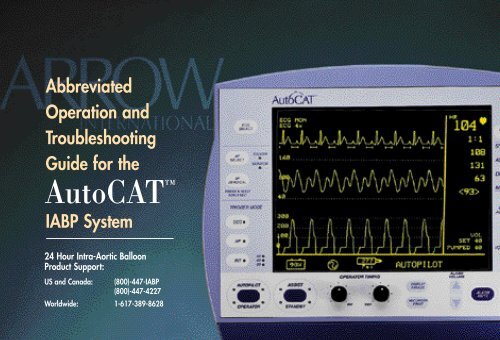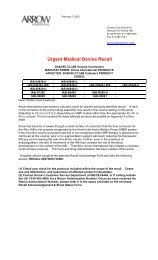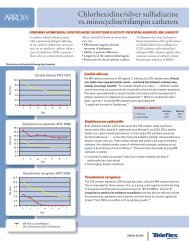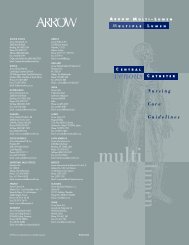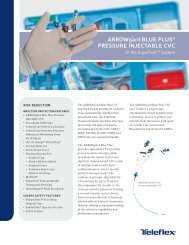AQR-M - Arrow International, Inc.
AQR-M - Arrow International, Inc.
AQR-M - Arrow International, Inc.
- No tags were found...
You also want an ePaper? Increase the reach of your titles
YUMPU automatically turns print PDFs into web optimized ePapers that Google loves.
AbbreviatedOperation andTroubleshootingGuide for theAutoCAT IABP System24 Hour Intra-Aortic BalloonProduct Support:US and Canada: (800)-447-IABP(800)-447-4227Worldwide: 1-617-389-8628
AUTOPILOT MODEIn AUTOPILOT mode the console selects the ECG source, AP source, trigger, and timing.1. Console scans all available ECG leads continuously. If the currently selected lead islost, the console will select the next clear ECG lead.2. AP source is selected by the console but can be changed by the operator.3. If trigger is lost, console will select alternate trigger.4. All timing settings and adjustments are under the control of the console.5. The console continuously assesses correlation of IAB diameter to patient’s aortic diameter. If the IAB is found to betoo large or too small for the patient’s aorta, the console will adjust the IAB volume to the maximum allowed inorder to correct this condition.6. All control keys and knobs, whose functions are adjusted by the console in AUTOPILOT mode, will not functionwhen this mode is selected.If, at any time, the operator prefers to take control of trigger, ECG source, timing, etc. this can be accomplished byselecting OPERATOR mode.OPERATOR MODEThis is the mode of operating all other models of intra-aortic balloon pumps use. The operator makes all choicesregarding ECG source, AP source, trigger, timing, and IAB volume.1. Once timing is set the console will automatically adjust timing for changes in heart rate and rhythm.
AUTOPILOT MODE INITIAL SET-UP1. Establish Power2. Check Helium Tank3. Connect ECG Source4. Connect AP Source5. Connect IAB Catheter6. Initiate PumpingTRIGGER MODESTrigger is the event the pump uses to identify the onset of the cardiac cycle (systole). The pump must have a consistenttrigger in order to provide patient assist. If the selected trigger signal can no longer be detected, counterpulsation willbe interrupted.Three different trigger selections are available.1. ECG: Note: trigger of choiceThe R-wave of the ECG is the trigger event. Automatic pacer spike rejection. ESIS (electrosurgical interferencesuppression) is active with skin leads. If no R-wave detected the pump will automatically look for the ventricularpacer spike of an AV pacer.- If triggering off a single V pacer spike is desired, select operator mode and press the ECG key once.V pacer trigger is now active.
2. AP:The systolic upstroke of the arterial pressure waveform is the trigger event. A 14mmHg minimum pulse pressure isrequired initially. Every 64th beat is unassisted and assessed by the console to ensure proper trigger. AP triggermay be used when ECG triggering is not possible.Note: To avoid late deflation, set the deflation point to occur prior to the systolic upstroke.Note: AP triggering is not recommended for use with irregular rhythms.3. INT:An internally generated signal provides asynchronous assist. May be set to 40, 60, or 80 assists per minute.Note: Should the system detect an R-wave while in internal trigger mode, an audible alarm is sounded and themessage ECG DETECTED appears on the monitor screen.Warning: Do not use internal trigger in the presence of any intrinsic cardiac activity; serious competitivehemodynamics will result.In AUTOPILOT mode, the console will choose the ECG trigger whenever available. Should all ECG signals be lost, theconsole will change to AP trigger. Once the ECG is re-established, the console will return to ECG trigger after twominutes when a regular rhythm is present. If an irregular rhythm is present, the console will return to ECG trigger afterone minute of recognition of the ECG signal.
TIMINGSmarTrak ® automatic timing algorithm provides beat to beat timing assessments. Automatic timing adjustments are made forheart rate and rhythm changes. The operator may adjust inflation and deflation points for the desired hemodynamic effects.Timing refers to the positioning of inflation and deflation in relation to the period of diastole on the arterial pressurewaveform. Inflation should be set to occur at the onset of diastole, which is signified by the dicrotic notch. Deflationshould be set to occur prior to ventricular ejection.Inflation and deflation markers appear on the arterial pressure waveform whenever the pump is in standby mode.Utilizing the timing controls allows the operator to adjust the inflation and deflation points to correspond to the period ofdiastole. Once assist is initiated, timing effects can be assessed by selecting the 1:2 assist ratio. Assisted and unassistedblood pressures are provided on the monitor screen. The assist markers always appear underneath the ECG for everytrigger event identified and can be utilized by the operator to further assist in timing assessments.Optimal timing is illustrated below:Assist Markers:DeflationCOMPARISON OF ASSISTED AND NATIVE PRESSURE TRACINGS.Inflation1. Aortic end-diastolic pressure. 2. Peak systolic pressure. 3. Dicrotic notch. 4. Augmented diastolic pressure. 5. Balloon aortic end-diastolic pressure. 6. Assisted peak systolic pressure.
ARRHYTHMIA TIMINGConventional timing becomes a challenge when the patient develops an irregular rhythm. The following options are available:1. ECG Trigger: During an arrhythmia, such as atrial fibrillation, the length of time the balloon is allowed to stayinflated varies on a beat to beat basis. The message ARRHYTHMIA TIMING will appear on the monitor screen.In OPERATOR MODE, this specialized afib timing maximizes systolic unloading during irregular rhythms bycontrolling deflation. If the patient returns to a regular rhythm, the message disappears and assist returns toconventional timing.Note: ECG trigger is the trigger of choice in the presence of irregular rhythm. If the clinician feels that ARRHYTHMIATIMING is not in the patient’s best interest, selecting the AFIB TIMING OFF key will turn off this feature. If the operatordesires to control the point of deflation during an irregular rhythm, this can be accomplished in OPERATOR MODE byselecting the AFIB TIMING OFF key.2. AP Trigger: Operator can fine tune inflation and deflation. Late deflation should always be avoided. Every 64THbeat is unassisted and assessed by the console to ensure proper trigger.Note: AP trigger is NOT recommended during irregular rhythms.TROUBLESHOOTING ALARM AND ALERT CONDITIONSThe <strong>Arrow</strong> AutoCAT system is equipped with a comprehensive surveillance system to notify the operator of alarm andalert conditions. You have the benefit of the entire system surveillance, alarm, and message capacity in both Autopilot and Operator modes of operation. Alarm conditions suspend counterpulsation assist. A message is displayed on themonitor screen and an audible alarm tone is sounded. Alert conditions do not suspend counterpulsation assist, a messageis displayed on the monitor screen and, in certain conditions, an audible alarm tone is sounded.
The following table provides an alphabetical listing of most of the alarm and alert messages, the pump response,possible causes and operator action to correct the condition.MESSAGE PUMP RESPONSE POSSIBLE CAUSE OPERATOR ACTIONAP TRIGGER ACTIVE Message only System has switched to AP triggerautomatically in Autopilot Modewhen a reliable ECG trigger cannotbe obtained.ARRHYTHMIA TIMING Message only Irregular cardiac rhythm or irregulartriggering.Check ECG source.Re-establish consistent ECG signalIf the rhythm is irregular, treat patientaccordingly.Ensure the trigger signal is clear;pump not triggering on artifact.If desired, the automatic afib timingcan be overridden by pressing AFIBTIMING OFF.AVL FAILURE Message only AVL not functioning properly Call for service. Try to reinitiatepumping by powering down andback up.BALLOON DISCONNECTAudible tone, message, deflateballoon; stop pumpingNo pressure in balloon line orballoon line not connected.Check gas tubing connections atconsole or at balloon connection.GAS ALARMS OFF Mode:Message onlyCall for service if all connections aretight and alarm condition persists.CALL SERVICEUnable to start pumping, displaymessage.Computer failureCall for service. Try to reinitiatepumping by powering down andback up.
MESSAGE PUMP RESPONSE POSSIBLE CAUSE OPERATOR ACTIONCHECK TIMINGActive in OPERATOR Mode only.Message.Pumping switched from AUTOPILOT Mode to OPERATOR ModeReminder to assess timing. Adjustas needed.A 2 second audible alert mayaccompany message if enabled.Assist interval set to short to fullyinflate balloon.Press ASSIST FREQ to 1:2 to evaluatetiming. Readjust timing as necessary.ECG DETECTEDMessage and beep tone every5 seconds.Cardiac activity (ECG) detected whilepumping in INTERNAL trigger.Switch trigger mode according topatient’s rhythm. Readjust timing.FILL FAILUREAudible tone, message, deflateballoon; stop pumpingGAS ALARMS OFF Mode: NoneFailure to fill to 6-10mmHg duringfill state.Press ASSIST key again. Check foradequate supply of helium. If alarmpersists, operate in GAS ALARMSOFF override mode until anotherconsole is available.FILL PRESSUREAudible tone, message, deflateballoon; stop pumping.Changing balloon volume whilepumping.If IAB volume was changed whilepumping, depress ASSIST and beginpumping again.High helium pressure in balloon line.Notify service if alarm conditioncontinues.GAS ALARMS OFF Message only Pump is set to GAS ALARMS OFFMode.Press and hold GAS ALARMS OFFkey for 3 seconds to turn this modeoff (LED off) and reactivate theautomatic surveillance systems.
MESSAGE PUMP RESPONSE POSSIBLE CAUSE OPERATOR ACTIONGAS LOSSAudible tone, message, deflateballoon; stop pumpingGAS ALARMS OFFMode: NoneLeak in IAB catheter.Leak in balloon line connections.Inspect balloon gas tubing for blood;if observed, discontinue pumpingand notify physician.Secure tubing connections.Insufficient helium pressure.Check to see if sufficient helium isavailable. Replace tank if necessary.HELIUM LOWMessage only. 1 hour autopurge isdisabled.Less than 100psi remaining in heliumtank.Replace helium tank. Check thathelium tank is properly seated.Ensure that external supply valveis open.Helium pressure transducermalfunction.Call for service.KINKED LINEAudible tone, message, deflateballoon; stop pumpingKink in balloon catheter or gastubing.Find kink or twist in the catheter ortubing and straighten.GAS ALARMS OFFMode: Message onlyLOW AIR DRIVEAudible tone, message, deflateballoon; stop pumpingGAS ALARMS OFFMode: Message onlyInsufficient air drive pressure toinflate the balloon.Change console. Operate in GASALARMS OFF override mode untilanother console available.Call for service.LOW VACUUMAudible tone, message, deflateballoon; stop pumpingInsufficient vacuum.Change console. Operate in GASALARMS OFF override mode untilanother console available.GAS ALARMS OFFMode: Message onlyCall for service.
MESSAGE PUMP RESPONSE POSSIBLE CAUSE OPERATOR ACTIONLOW (BATTERY)Message "LOW" inside batterysymbol flash and beep tone every5 secondsBattery voltage low; less than 20minutes of battery operation remain.Attach power cord to AC supply assoon as possible to recharge batteryand maintain pumping.MAP BELOW LIMITMessage and beep tone every5 secondsMean Arterial Pressure (AP) belowoperator set limit.Decrease the AP threshold limit.Reassess patient’s hemodynamics.NOISY ECGAudible tone, message, deflateballoon on first segment of noise.Reverts to STANDBY if more than 4seconds of noise persists.Oscillatory noise in ECG. Patientmuscle activity.Change position of ECG leads.Check all connections and leads.Select another lead. Select anothertrigger.Electrocautery in use.Change to AP trigger.Possible faulty ground in theAC outlet.Change AC source.NO TRIGGERAudible tone, message, deflateballoon; stop pumpingIn AUTOPILOT Mode: all triggersignals lost to the pump.CHECK PATIENT FOR CARDIACACTIVITY.Pumping resumes if triggerre-established within 5 minutesIn OPERATOR mode: the currentlyselected trigger has been lost.Check connections.Loose or disconnected ECG leads.Check leads and connections.ECG signal too small.Change lead selection; changetrigger source. Check electrodeplacement.Monitor input disconnected.Check input from monitor and secure.If using AP, arterial line dampened,disconnected, or turned OFF.Check arterial tracing; flush line;change to ECG trigger; checktransducer and monitor input.Patient’s cardiac activity ceased.CHECK PATIENT FOR CARDIACACTIVITY.
MESSAGE PUMP RESPONSE POSSIBLE CAUSE OPERATOR ACTIONPUMP IN STANDBYMessage and beep tone every5 secondsPump in STANDBY over 5 minutes.Press ASSIST to resume pumping. Orpress ALARMS MUTE if wish toremain in STANDBY.REPLACE HELIUM NOWMessage and beep tone every5 secondsHelium tank is empty.Replace helium tank immediately.SYSTEM RESETSystem alarms with logo; unable tostart pumpingImproper computer operation.Call for service. Try to reinitiatepumping by powering down andback up.UNABLE TO ZERO APAlarm and message erase when APZERO/CAL button is releasedAttempts to ZERO with APsignal present.Check stopcock and line setup.ZERO/CAL with stopcock turned offto the patient.CONSTANT ALARM TONE(NO MESSAGE)No message, deflate balloon; stopspumpingProlonged balloon inflation.Call for service. Try to reinitiatepumping by powering down andback up.BALLOON PRESSURE WAVEFORMS:USE IN TROUBLESHOOTING ALARM CONDITIONSThe BPW is obtained from a built-in pressure transducer attached to the patient side of the isolator assembly.Alarm conditions are detected by a change of pressure in the closed system on the patients side.
Normal Balloon Pressure Waveform:A. Balloon pressure baselineB. Rapid inflationC. Pressure overshoot (peak inflation artifact)D. Balloon plateauE. Plateau endpointF. DeflationG. Zero-undershoot (peak deflation artifact)Normal Variations:BRADYCARDIA TACHYCARDIA HYPOTENSION HYPERTENSION
Abnormal Balloon Pressure Waveforms:Low or Falling BaselinePossible Alarm: GAS LOSSHigh Balloon Pressure BaselinePossible Alarm: FILL PRESSUREPlateau Lost or DistortedPossible Alarm: KINKED LINE, GAS LOSS
®INTERNATIONAL2400 Bernville Road, Reading, PA 19605 USAARROW 24 HOUR INTRA-AORTIC BALLOON PRODUCT SUPPORT:US and Canada(800)-447-IABP(800)-447-4227Worldwide 1-617-389-8628©2001 <strong>Arrow</strong> <strong>International</strong>, <strong>Inc</strong>. All rights reservedPrinted in Czech Republic<strong>AQR</strong>-M 08/01 5M CZ


